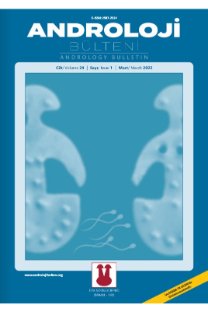Azospermi tanılı her hastaya mikroskopik testiküler sperm ekstraksiyonu öncesi perkütan testiküler sperm aspirasyonu yapılmalı mı?
AMAÇ: Azospermili erkeklerde perkütan testiküler sperm aspirasyonu (PTSA) basit, minimal invaziv bir yaklaşım olarak bilinmektedir. Bu çalışmanın amacı ilk girişim olarak PTSA yapılmasının yararını araştırmaktır. GEREÇ ve YÖNTEM: Hastanemizde non-obstruktif azospermi (NOA) tanısı alan ve mikrocerrahi testiküler sperm ekstraksiyonu (mTESE) ve PTSA yapılan 128 ardışık hastanın tıbbi verileri retrospektif olarak incelendi. Hastalardan serum total testosteron (T), foliküler uyarıcı hormon (FSH), luteinize edici hormon (LH), ve prolaktin (PRL) düzeyleri istendi. Hastalara genetik analiz yapıldı. Verileri değerlendirilen 128 NOA hastasına tek cerrah tarafından önce PTSA ve sperm bulunamaması durumunda mTESE yapıldı. Hastalar PTSA, sperm bulunan mTESE ve sperm bulunamayan mTESE olarak 3 gruba ayrıldı. BULGULAR: Üç grup arasında yaş, FSH, LH, Prolaktin ve Testosteron değerleri arasında istatistiksel olarak anlamlı fark saptanmadı (p>0,05). Üç grup arasında infertilite süresi açısından anlamlı fark izlendi (p
Should percutaneuous testicular sperm aspiration be performed before testicular sperm extraction in all patients with azoospermia?
OBJECTIVES: Percutaneuous testicular sperm aspiration (PTSA) is known as an easy and minimal invasive procedure in men who have azospermia. In this study we are in the aim of evaluating if PTSA is beneficial as a first step procedure. MATERIAL and METHODS: In our study we analyzed the records of 128 patients who underwent mTESE and PTSA with the diagnosis of non-obstructive azoospermia (NOA) retrospectively. The serum levels of total testosterone (T), follicular stimulating hormone (FSH), luteinizing hormone (LH) and prolactine (PRL) were measured in all patients. All the patients underwent genetical analysis. The patients diagnosed with NOA underwent PTSA which was performed by only one surgeon at first, then mTESE was performed secondly by the same surgeon if there was no sperm extraction wşth PTSA. All of 128 patients were evaluated in three groups; sperm extracted patients with PTSA, sperm extracted patients with mTESE and no sperm extracted patients with any procedures. RESULTS: There were no significant differences between the serum levels of FSH, LH, PRL, T and age statistically (p>0.05) but it differs significantly in all three groups regarding the periods of infertility. The patients who have pain were scored with VAS (Visual Analogue Scale) was 1.93±0.96 for the group sperm extracted patients with PTSA; 2.32±0.74 for the group of sperm extracted patients with mTESE and 5.41±1.15 for the group of no sperm extraction with any procedures respectively. CONCLUSION: In this study it cannot be predicted which patient may benefit by the PTSA procedure. We are of opinion that performing PTSA before mTESE procedure may be beneficial regarding to low morbidity risk.
___
- Katz DJ, Teloken P, Shoshany O. Male infertility - The otherside of the equation. Aust Fam Physician 2017;46:641–6. Erişim: https:// www.racgp.org.au/afp/2017/september/male-infertility/
- Jarow JP, Espeland MA, Lipshultz LI. Evaluation of the azoospermic patient. J Urol 1989;142:62–5. [CrossRef]
- Yucel C, Keskin MZ, Cakmak O, Ergani B, Kose C, Celik O, et al. Predictive value of preoperati ve inflammation-based prognostic scores (neutrophil-to-lymphocyteratio, platelet-to-lympho cyteratio, and monocyte-to eosinophil ratio) in testicular sperm extraction: a pilot study. Andrology 2017;5:1100–4. [CrossRef]
- Schlegel PN. Nonobstructive azoospermia: a revolutionary surgical approach and results. Semin Reprod Med 2009;27:165–70. [CrossRef]
- Khadra AA, Abdulhadi I, Ghunain S, Kilani Z. Efficiency of Percutaneous Testicular Sperm Aspiration as a Mode of Sperm Collection for Intracytoplasmic Sperm Injectionin Nonobstructive Azoospermia. Urology;169:603–5. [CrossRef]
- Bernie AM, Mata DA, Ramasamy R, Schlegel PN. Comparison of microdissection testicular sperm extraction, conventional testicular sperm extraction, and testicular sperm aspiration for nonobstructive azoospermia: a systematic review and meta-analysis. Fertil Steril 2015;104:1099–1103.e3. [CrossRef]
- Esteves SC, Miyaoka R, Orosz JE, Agarwal A. An update on sperm retrieval techniques for azoospermic male. Clinics 2013;68:99– 110. [CrossRef]
- El-Haggar S, Mostafa T, Abdel Nasser T, Hany R, Abdel Hadi A. Fine needle aspiration vs. mTESE in non-obstructive azoospermia. Int J Androl 2008;31:595–601. [CrossRef]
- Jensen CFS, Ohl DA, Hiner MR, Fode M, Shah T, Smith GD, Sonksen J. Multiple needle-pass percutaneous testicular sperm aspiration as firstline treatment in azoospermic men. Andrology 2016;4:257–62. [CrossRef]
- Ramasamy R, Padilla WO, Osterberg EC, Srivastava A, Reifsnyder JE, Niederberger C, Schlegel PN. A comparison of models for predicting sperm retrievalbe for emicrodissection testicular sperm extraction in men with nonobstructive azoospermia. J Urol 2013;189:638–42. [CrossRef]
- Vloeberghs V, Verheyen G, Haentjens P, Goossens A, Polyzos NP, Tournaye H. How successful in TESE-ICSI in couples with non-obstructive azoospermia. Hum Reprod 2015;30:1790–6. [CrossRef]
- Bouker A, Halouani L, Kharouf M, Latrous H, Makni M, Marrakchi O, et al. Step-by-step loupes-mTESE in nonobstructive azoospermic men, a retrospective study. Basic Clin Androl 2019;29:11. [CrossRef]
- Erdem E, Karacan M, Çebi Z, Uluğ M, Arvas A, Çamlıbel T. Results of intracytoplasmic sperm injection performed with sperm retrieved by microscopic testicular sperm extraction in azoospermic patients. Turk J Urol 2018;44:462–6. [CrossRef]
- Maglia E, Boeri L, Fontana M, Gallioli A, De Lorenzis E, Palmisano F, et al. Clinical comparison between conventional and microdissection testicular sperm extraction for non-obstructive azoospermia: Understanding which treatment Works for which patient. Arch Ital Urol Androl 2018;90:130. [CrossRef]
- Ma Y, Li F, Wang L, Zhao W, Li D, Xian Y, Jiang X. A risk prediction model of sperm retrieval failure with fine needle aspiration in males with non-obstructive azoospermia. Hum Reprod 2019;34:200–8. [CrossRef]
- Wood S, Thomas K, Sephton V, Troup S, Kingsland C, LewisJones I. Postoperative pain, complications, and satisfaction rates in patients who undergo surgical sperm retrieval. Fertil Steril 2003;79:56–62. [CrossRef]
- ISSN: 2587-2524
- Yayın Aralığı: Yılda 4 Sayı
- Başlangıç: 1999
- Yayıncı: Turgay Arık
Sayıdaki Diğer Makaleler
Adölesan varikosel tedavisinde uygulanan üç farklı cerrahi yöntem sonuçlarının karşılaştırılması
MURAT UÇAR, Ahsen KARAGÖZLÜ AKGÜL, Ahmet Ender CAYLAN, Bilge TÜREDİ, Mustafa Faruk USTA, Nizamettin KILIÇ, Emin BALKAN, Erol GÜNTEKİN
Ebelik öğrencilerinin evlilik dışı cinsel ilişki hakkındaki görüş ve tutumları
Saadet Gonca MAVİ AYDOĞDU, Betül UZUN, DUYGU MURAT ÖZTÜRK
Evlilik süresinin prematür ejakülasyona etkisi
Erdem KISA, Mehmet Zeynel KESKİN
CAVİT CEYLAN, ŞENOL TONYALI, Serkan DOĞAN, Sedat YAHŞİ, Emre UZUN
